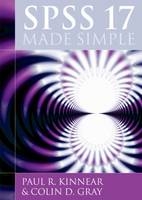
PASW Statistics 17 Made Simple (replaces SPSS Statistics 17)
Psychology Press Ltd (Verlag)
978-1-84872-026-8 (ISBN)
- Titel ist leider vergriffen;
keine Neuauflage - Artikel merken
SPSS is now PASW Statistics!
Reflecting the latest developments in statistics software from SPSS Inc., this new edition of one of the most widely read textbooks in its field keeps the reader abreast of the latest improvements in PASW Statistics 17 (the new name for SPSS Statistics 17).
This friendly and informal textbook is a non-technical and readable introduction to one of the most powerful and versatile statistical packages on the market. The new edition combines clarity of presentation with coverage of the latest improvements in the software and where necessary, the coverage has been extended to include topics in which our readers have expressed particular interest. The previous edition included more advice about the use of the control language or syntax, and coverage has been further extended in the present edition to show the reader how to use the improved PASW syntax editor. While being updated and expanded to cover new features, the book will continue to be useful to readers with previous versions (SPSS 16 and earlier).
Each statistical technique is presented in a realistic research context and is fully illustrated with screen shots of PASW dialog boxes and output. The book also provides guidance on the choice of statistical techniques and advice (based on the APA guidelines) on how to report the results of statistical analyses. The first chapter sets the scene with a survey of typical research situations, key terms and advice on the choice of statistical techniques. It also provides clear signposts to where each technique can be found in the body of the book. The next chapters introduce the reader to the use of PASW, beginning with the entry, description and exploration of data. There is also a full description of the powerful capabilities of the versatile Chart Builder. Each of the remaining chapters concentrates on one particular kind of research situation and the statistical techniques that are appropriate.
In summary, PASW Statistics 17 Made Simple:
Gets you started with PASW.
Shows you how to run an exploratory data analysis (EDA) using PASW's extensive graphics and data-handling menus.
Reviews the elements of statistical inference.
Helps you to choose appropriate statistical techniques.
Warns you of the pitfalls arising from the misuse of statistics.
Shows you how to report the results of a statistical analysis.
Shows you how to use syntax to implement some useful procedures and operations.
Has a comprehensive index, which allows you to find a topic by several different routes.
Has a comprehensive glossary.
The book is accompanied by online instructor resources, including a PowerPoint lecture course and a multiple-choice question bank. The book’s dedicated website also features a comprehensive set of exercises to familiarize the reader with inputting data and choosing statistical techniques. Please visit www.psypress.com/pasw-statistics for more details.
Paul Kinnear, formerly Head of the School of Psychology, University of Aberdeen Colin Gray, Senior Lecturer, School of Psychology, College of Life Sciences and Medicine, University of Aberdeen
Preface. 1. Introduction. 2. Getting Started with PASW (Formerly SPSS) Statistics 17.0. 3. Editing and Manipulating Files. 4. Exploring your Data. 5. Graphs and Charts. 6. Comparing Averages: Two-Sample and Onesample Tests. 7. The One-Way ANOVA. 8. Between Subjects Factorial Experiments. 9. Within Subjects Experiments. 10. Mixed Factorial Experiments. 11. Measuring Statistical Association. 12. Regression. 13. Analyses of Multiway Frequency Tables & Multiple Response Sets. 14. Discriminant Analysis and Logistic Regression. 15. Latent Variables: Exploratory Factor Analysis & Canonical Correlation. Appendix. Glossary. References. Index.
| Erscheint lt. Verlag | 17.7.2009 |
|---|---|
| Verlagsort | Hove |
| Sprache | englisch |
| Maße | 174 x 246 mm |
| Gewicht | 1293 g |
| Themenwelt | Mathematik / Informatik ► Mathematik ► Computerprogramme / Computeralgebra |
| ISBN-10 | 1-84872-026-2 / 1848720262 |
| ISBN-13 | 978-1-84872-026-8 / 9781848720268 |
| Zustand | Neuware |
| Haben Sie eine Frage zum Produkt? |
aus dem Bereich


